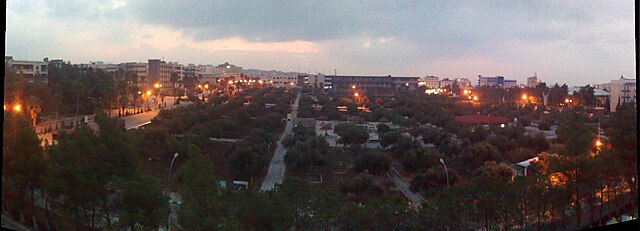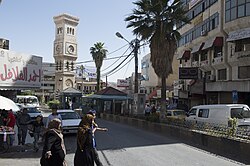Top Qs
Timeline
Chat
Perspective
Irbid
City in Irbid Governorate, Jordan From Wikipedia, the free encyclopedia
Remove ads
Irbid (Arabic: إِربِد), known in ancient times as Arabella or Arbela (Άρβηλα in Ancient Greek), is the capital and largest city of Irbid Governorate. It has the second-largest metropolitan population in Jordan after Amman, with a population of around 2,003,800.[3] As a city, Irbid is Jordan's third-largest, after Amman and Zarqa.
Irbid is located about 70 kilometres (43 mi) north of Amman on the northern ridge of the Gilead, equidistant from Pella, Beit Ras (Capitolias), and Um Qais, and approximately 20 kilometres (12 mi) south of the Syrian border.
Irbid was built on successive Early Bronze Age settlements and was possibly the biblical Beth Arbel and the Arbila of the Decapolis, a Hellenistic league of the 1st–2nd century BCE. The population of Irbid swelled in the late 19th century, and prior to 1948 it served as a significant centre of transit trade.[4]
The greater Irbid Municipality was established in 1881 in the Ottoman era.[5] It is the oldest municipality in Jordan.
The city is a major ground transportation hub between Amman, Syria to the north, and Mafraq to the east. The Irbid region is also home to several colleges and universities.
Remove ads
Name
The place-name Ἄρβηλα for present-day Irbid is first documented on civic bronze coins of the Decapolis struck in the late first century BCE and the early first century CE,[6][7] with the same Greek form recorded in 1 Maccabees 9 2 and in Josephus, Antiquities 12 11 1.[8][9] The variant ʾrbl appears in Nabataean Aramaic inscriptions and in Safaitic Old Arabic graffiti dating from roughly the first century BCE to the third century CE,[10][11][12] and Eusebius lists a village called Arbela across the Jordan near Pella in his fourth-century Onomasticon.[13] Excavations on Tell Irbid show continuous occupation from at least the Early Bronze Age around 3200 BCE,[14][15] placing the settlement more than two millennia before these Hellenistic attestations and more than three millennia before the earliest archaeological evidence for a permanent Jewish community in the northern Transjordan, which appears with the third or fourth century CE synagogue at Gerasa.[16][17]
Remove ads
History
Summarize
Perspective

Artifacts and graves in the area show that Irbid was inhabited in the Bronze Age. Pieces of pottery and wall stones found at Tell Irbid were estimated to be made in the year 3200 B.C.[18] A city wall dated to around 1300–1200 BC.
- Phase III (c. 3200 BC)
- Phase II (c. 1300–1150 BC)
- Phase I (c. 1150–800 BC)
In the Hellenistic period, Irbid—then known as Arabella—was a major trade center. Before the advent of Islam, Arabella was famous for producing some of the best wines in the ancient world. The area in the region had extremely fertile soil and moderate climate, allowing the growing of high quality grapes.[19][20][21]
During the Early Muslim conquests, the city came under the rule of the Rashidun Caliphate in 634 and became known as Irbid, at which time it shifted from wine to olive oil production. Wheat was also an important product in the area.[22]
In 1596 it appeared in the Ottoman tax registers named as Irbid, situated in the nahiya (subdistrict) of Bani Juhma, part of the Hauran Sanjak. It had 72 households and 35 bachelors; all Muslim. The villagers paid a fixed tax-rate of 25% on agricultural products; including wheat (22,500 akçe), barley, summer crops, fruit trees, goats and bee-hives; in addition to a market toll. The total tax was 38,116 akçe.[23]
In 1838, Eli Smith noted Irbid (Arbela) as being a place with Sunni Muslim.[24]
The Jordanian census of 1961 found 44,585 inhabitants in Irbid.[25]
The city is home to four major universities: Yarmouk University, Jordan University of Science and Technology, Irbid National University and Jadara University. In addition, it has two campuses of Balqa Applied University and several private colleges.
Though not otherwise a major tourist destination, Irbid has two notable museums: the Museum of Jordanian Heritage and the Jordan Natural History Museum, both on the campus of Yarmouk University. Furthermore, Irbid's strategic location in northern Jordan makes it a convenient starting point for tourists interested in seeing the northern Jordan Valley; visiting Umm Qais, Beit Ras (Capitolias), Pella, Ajloun, Umm el-Jimal and other historical sites; or travelling on to Syria.
Remove ads
Geography
Summarize
Perspective
Irbid is situated in northern Jordan, on a fertile plateau. As of 2010, the city of Irbid encompassed an area of 30 km2, with residential areas making up 74.3% of the total area, followed by the Services areas occupying 9.5%, then Empty or unoccupied areas of 7.7%, then 4.2% is classified as Commercial areas, and 3.3% as Industrial areas, and finally gardens occupied 1% of the total city area.
Border cities
Climate
Irbid has a hot-summer Mediterranean climate (Köppen: Csa), common in the Levant region. Summers are hot at days with warm nights, while winters are cool and wet, with two snowy days on average.
Demographics
Demographic distribution
The city of Irbid is located in Irbid Governorate. It is the largest city in Jordan after Amman and Zarqa. It is considered the economic centre of northern Jordan. The greater Irbid municipality encompasses Irbid city with its surrounding areas (population about 2,050,300) making it the second largest metropolitan area in Jordan and the seventh in the Levant.
History
Irbid was one of the major towns of the territories of Jordan in the Ottoman era. One of the earliest censuses of Irbid was conducted by the Ottomans in 1596 where 72 households were recorded.[23] The town gained importance after the creation of Transjordan region by the British after the first world war, as it was one of the major towns in that area.[27]
Irbid's population increased significantly as part of Jordan's overall population growth, with notable peaks in 1948, 1967, and 2011 due to refugee crises in neighbouring countries.
Remove ads
Districts of Greater Irbid Municipality

Irbid is divided into city districts forming smaller cities within the metropolitan sphere of influence of Irbid:
Remove ads
Hospitals
Irbid is known for its healthcare infrastructure.[citation needed] The largest hospitals in Irbid are:

- Abu Obaida Hospital
- Al-Najah Hospital
- Al-Qawasmi Hospital
- Al-Ramtha Hospital
- Al-Yarmouk Hospital
- Ibn-Alnafees Hospital
- Irbid Islamic Hospital
- Irbid Speciality Hospital
- King Abdullah University Hospital
- Muath Bin Jabal Hospital
- Prince Rashid Bin Al Hassan Hospital
- Princess Badea'a Hospital
- Princess Basma Hospital
- Princess Rahma Hospital
- Princess Raya Hospital
- Rahbat Al-Wardieh Hospital
- Roman Catholic Hospital
Remove ads
Education
As of 2007, there were 70,000 registered students in Irbid's 10 universities, community colleges and institutes, of whom 8,000 were international students from 47 countries.[28] This high concentration of institutions of higher education has played a role in the identity of the city.[citation needed] The largest universities in Irbid are:


- Yarmouk University[29]
- Jordan University of Science and Technology[30]
- Irbid National University[31]
- Al-Balqa` Applied University (Irbid campus)[32]
- Jadara University[33]
Some of the private schools in Irbid (sorted by alphabetical order):
- Al-Jeel Al Jadeed School
- Al-Manara Schools
- Al-Nahda Private School
- American University School of the Middle East [34]
- Arar Academy Schools
- Dar Al Uloum Schools
- Greek Catholic School
- Irbid International Schools
- Irbid Model School
- Islamic School (Al-Madares Al-Islamiya)
- Jordan National Schools
- King Abdullah II School for Excellence
- Rosary Sisters School
- Summit International Academy National
- Yarmouk University Model School
Remove ads
Economy

Most of the city's economy is based on the services sector, that is directly or indirectly related to the higher education institutions in the city, as an example there are 26 book publishing companies in the city. The number of internet cafes per capita is the highest in the world that took Irbid to the Guinness Book of World Records.[35] Irbid is considered the cultural capital of Jordan.[36] There is one Qualifying Industrial Zone in Irbid.
Remove ads
Sports
The Irbid-based club Al-Hussein (Irbid) was ranked fourth in the Jordanian football premier league in the year 2008. Its home matches are held in Prince Hasan Youth City's Stadium. The other major football club in Irbid is Al-Arabi. Established in 1945, it is one of the oldest athletic clubs in the country. As of 2008, there are 22 cultural and sport clubs registered in Irbid. Irbid hosted the 1999 Pan Arab Games.
Twin towns – sister cities
Irbid is twinned with:
Notable people
See also
Citations
General bibliography
External links
Wikiwand - on
Seamless Wikipedia browsing. On steroids.
Remove ads









